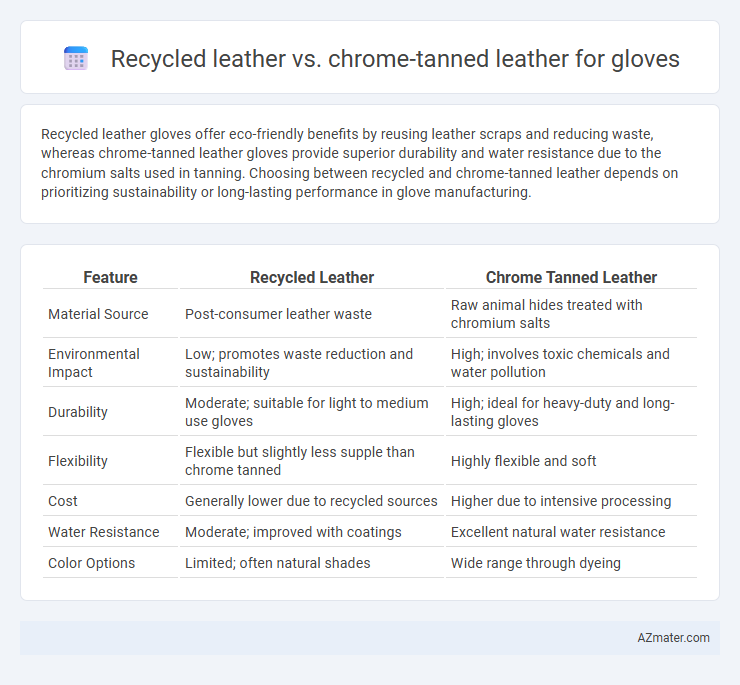Recycled leather gloves offer eco-friendly benefits by reusing leather scraps and reducing waste, whereas chrome-tanned leather gloves provide superior durability and water resistance due to the chromium salts used in tanning. Choosing between recycled and chrome-tanned leather depends on prioritizing sustainability or long-lasting performance in glove manufacturing.
Table of Comparison
| Feature | Recycled Leather | Chrome Tanned Leather |
|---|---|---|
| Material Source | Post-consumer leather waste | Raw animal hides treated with chromium salts |
| Environmental Impact | Low; promotes waste reduction and sustainability | High; involves toxic chemicals and water pollution |
| Durability | Moderate; suitable for light to medium use gloves | High; ideal for heavy-duty and long-lasting gloves |
| Flexibility | Flexible but slightly less supple than chrome tanned | Highly flexible and soft |
| Cost | Generally lower due to recycled sources | Higher due to intensive processing |
| Water Resistance | Moderate; improved with coatings | Excellent natural water resistance |
| Color Options | Limited; often natural shades | Wide range through dyeing |
Introduction to Glove Leather Materials
Glove leather materials primarily include recycled leather and chrome-tanned leather, each offering distinct benefits for durability and comfort. Recycled leather, made by reprocessing leather scraps, provides an eco-friendly option with a softer texture ideal for lightweight gloves. Chrome-tanned leather uses chromium salts for tanning, resulting in highly durable, flexible gloves resistant to water and wear, preferred for heavy-duty applications.
What is Recycled Leather?
Recycled leather is made by processing leftover leather scraps and fibers from production waste, combining them with a bonding material to create a new, eco-friendly material for gloves. This recycled leather offers a sustainable alternative with reduced environmental impact compared to chrome tanned leather, which involves chemical-heavy tanning processes using chromium salts. Gloves made from recycled leather provide durability and flexibility while minimizing toxic chemical usage, making them ideal for environmentally conscious consumers.
Understanding Chrome Tanned Leather
Chrome tanned leather, widely used in glove manufacturing, undergoes a chemical tanning process using chromium salts, resulting in a supple, water-resistant, and durable material ideal for prolonged wear and flexibility. Compared to recycled leather, chrome tanned leather offers superior strength, consistent texture, and enhanced resistance to heat and moisture, making it preferred for heavy-duty applications. Its production involves significant environmental considerations due to chromium waste, contrasting with the eco-friendlier profile of recycled leather alternatives.
Production Process Comparison
Recycled leather gloves are produced by breaking down leather scraps and fibers, which are then reconstituted and bonded with adhesives to create new material, significantly reducing waste and resource consumption. Chrome tanned leather gloves undergo a chemical tanning process using chromium salts to preserve the hide, resulting in durable and flexible leather but involving toxic substances that require careful management. The production of recycled leather emphasizes sustainability and lower environmental impact, whereas chrome tanning prioritizes leather quality and longevity, often at a higher ecological cost.
Durability: Recycled vs Chrome Tanned Leather Gloves
Recycled leather gloves typically exhibit reduced durability compared to chrome-tanned leather gloves due to the lower strength of reprocessed fibers. Chrome-tanned leather gloves offer superior resistance to wear, moisture, and environmental stress, making them ideal for heavy-duty use. The tanning process in chrome leather enhances flexibility and longevity, ensuring gloves maintain their protective qualities over extended periods.
Environmental Impact and Sustainability
Recycled leather gloves significantly reduce waste by repurposing post-consumer leather scraps, lowering the demand for new raw materials and minimizing landfill contributions. Chrome tanned leather, while durable and flexible, relies on chromium salts in its tanning process, which pose environmental hazards due to toxic waste and water pollution when improperly managed. Choosing recycled leather enhances sustainability efforts by promoting circular economy principles and reducing the ecological footprint compared to traditional chrome tanning methods.
Comfort and Performance in Gloves
Recycled leather gloves offer enhanced breathability and eco-friendly comfort due to their natural fibers and reduced chemical use, promoting better hand ventilation during extended wear. Chrome tanned leather provides superior durability and water resistance, maintaining shape and performance under heavy use, making it ideal for tasks requiring robust protection. Prioritizing recycled leather enhances sustainability and comfort for light to moderate activities, while chrome tanned leather delivers optimal performance and longevity in demanding environments.
Cost Analysis: Which is More Affordable?
Recycled leather gloves tend to be more affordable due to lower production costs and the use of reclaimed materials, reducing raw material expenses significantly. Chrome tanned leather gloves generally incur higher costs linked to the chemical tanning process and premium quality hides. Consumers prioritizing budget-friendly options often opt for recycled leather without compromising basic durability and aesthetics.
Market Availability and Consumer Trends
Recycled leather gloves are gaining traction in the market due to increasing consumer demand for sustainable and eco-friendly products, with availability expanding through specialty retailers and online platforms. Chrome tanned leather gloves remain widely available and popular for their durability, affordability, and traditional appeal, especially in workwear and fashion sectors. Consumer trends show a growing preference for recycled leather gloves among environmentally conscious buyers, while chrome tanned leather maintains dominance in markets prioritizing cost-efficiency and performance.
Which Leather is Best for Gloves?
Recycled leather for gloves offers an eco-friendly option by repurposing leather scraps, providing durability with reduced environmental impact. Chrome tanned leather delivers superior softness, flexibility, and resistance to wear, making it ideal for high-performance gloves. Choosing the best leather depends on balancing sustainability with desired durability and comfort for specific glove applications.

Infographic: Recycled leather vs Chrome tanned leather for Glove
 azmater.com
azmater.com